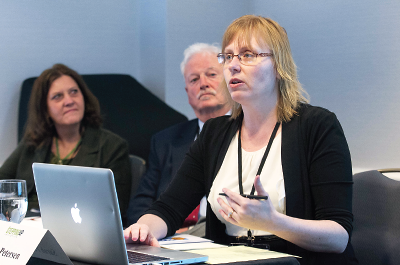Take it from Sarah Petersen: There’s more than one way to get past a wall. If you can’t go through it, maybe you can go over it or around it.
There are all kinds of walls out there, like the metaphorical one she confronted when a county bond issue to build a new jail in Codington County, S.D., failed at the polls, said Petersen, the county’s welfare director, at the Stepping Up Initiative’s summit last month in Washington, D.C. The initiative seeks to reduce the number of people with mental illnesses in the criminal justice system.
In fact, it was the bond issue’s defeat that led her to take part in the initiative and thus have the chance to meet with many of her peers from smaller counties around the country.
“Don’t think about what you cannot do,” she said on a panel about challenges in rural communities. “Think about what you can do, about what is possible.”
Instead of erecting a new building, what was possible was hiring a licensed professional counselor funded by the county welfare office to work at the jail 20 hours a week, screening and stabilizing inmates and doing crisis intervention. The counselor also plans discharge and rehabilitation.
Petersen also adapted many useful approaches developed elsewhere. For example, deputies couldn’t be taken off duty for a solid week as is standard for Crisis Intervention Team training. Petersen arranged for the training to take place just one day a week for five weeks so as not to disrupt schedules. And rather than funding a separate building for housing people in crisis, she rents a room in a local motel on a monthly basis, so it’s always available.
There are advantages and disadvantages to working in small counties.
“In my city, the strategic plan is one page,” said Petersen.
True, there may be fewer resources, but it’s also easier to know everyone in county government, said Patrick Fleming, a National Association of Counties fellow and the retired director of behavioral health services in Salt Lake County, Utah.
“Elected officials in small counties stay in office longer,” said Fleming. “They can make things work, and they can reallocate funds.”
However, the locus of control varies from state to state. In South Dakota, for instance, the state delivers county jail mental health services, so it must be the avenue for change. In New Mexico, the state contracted with a managed care organization to provide mental health care in the jails. In Utah, where Fleming worked for many years, the counties were responsible for mental health care so means had to be found to shift state funding to them.
Both Fleming and Petersen expressed reservation about grants. The application process takes up too much time for her small staff, said Petersen.
“And it’s hard to come up with replacement dollars when the grant is up,” said Fleming.
The National Association of County Behavioral Health and Developmental Disability Directors (NACBHDD) is embarking on its “Decarceration Initiative” to help rural counties find ways to prevent people with mental illnesses form going to jail in the first place.
This includes developing or improving the local crisis-response system, building relationships between police and the mental health system, creating a peer-support system in the jails to lower the distress levels of incoming prisoners, and linking released prisoners to community services, said Ron Manderscheid, Ph.D., executive director of NACBHDD.
“We are also creating groups of four or five small counties to work together online, to talk back and forth and share ideas,” said Manderscheid.
Overall, said Petersen, leaders in small counties need to reach out to other jurisdictions, to find common ground, build trust, share information, and work together.
“Do what you can do in your community,” added Fleming. “Build momentum.” ■
More information on Stepping Up can be accessed
here.

